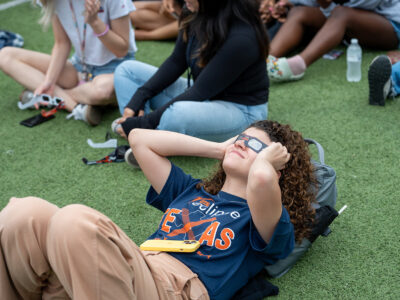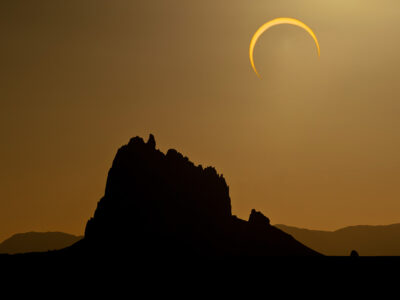The chances of experiencing a total solar eclipse are low, but it’s a spectacle that Angela Speck says everyone must witness at least once in their lifetime. The phenomenon takes place about every 375 years on average in any one specific location.
That’s why what’s happening in San Antonio right now is so remarkable. The Alamo City already caught “Eclipse Fever” when an annular “Ring of Fire” eclipse mostly obscured the sun on October 14, 2023. On April 8, however, those in San Antonio and many spots in the Hill Country along the path of totality — the narrow strip of land where the eclipse can be seen in its entirety — will witness the most awe-inspiring of them all: a total solar eclipse.
The last total solar eclipse to grace the United States was on August 21, 2017. The April 8 eclipse will be the last chance to catch a total solar eclipse stateside until 2044.
UTSA’s Ari Castañeda sat down with Dr. Speck, professor and chair in the UTSA College of Sciences’ physics and astronomy department, to learn more about these fascinating astronomical events. Speck is the co-chair of the American Astronomical Society Solar Eclipse Task Force and one of the world’s leading eclipse experts.
Angela Speck was the guest for the first episode of the Planet UTSA podcast, providing a preview for April’s total solar eclipse.

You know eclipses. What is your most favorite thing about them?
AS: It’s hard to convey just how amazing it is to experience an eclipse. One thing is that it’s not just visual. Obviously, it’s gorgeous to look at but you also feel it on your skin because it cools down and you get a breeze. There’s also sounds depending on where you are. Right before a total eclipse, the birds get loud and then when it goes dark, they are quiet. For me, it’s not just one thing. You have all this stuff going on all at once and you have a very limited time to take everything in. It’s kind of very intense.
What happens during an annular eclipse versus a total solar eclipse?
AS: With any type of solar eclipse, you get a partial eclipse. By that I mean part of the sun is visible and part of the sun is hidden. Depending on where you are, you may get the moon directly between us and the sun. That’s what we’re going to see here.
In the case of an annular eclipse, you’re going to see a partial eclipse until the moon is directly in the way. It’s still technically a partial eclipse because we can see part of the sun. We see the edge of the sun all the way around the moon. That’s the annular eclipse because annulus is a fancy word for donut. It takes about an hour and a half for the partial phase and then, for maybe four minutes or so, it’s in annularity, where we see a ring of fire. Then you have another hour and a half of partial. For the total eclipse, we still see the partial but once the moon is completely in the way, it blocks out the whole sun.
At this point, it’s hugely different from an annular eclipse. As the moon is blocking out the sun, you won’t notice it’s getting darker until the sun is about 75-85% eclipsed because your eyes dilate, your pupils get bigger and let in more light. You won’t notice, but it’ll feel like something is not quite right because it’s getting darker.
As you get toward the end, it goes from what is like an overcast day to full-moon dark in the space of a minute. When it’s full-moon dark, you can see the corona, which is the atmosphere of the sun. You can also see stars and planets and all the way around the horizon, you can see sunset colors.
When was the last time we had the opportunity to view an eclipse and when will be our next?
AS: The last time the U.S. had a total eclipse was in 2017, but that one wasn’t visible from Texas. It was partial from here. The last time we had one here was like hundreds of years ago. The next time there will be a total eclipse in Texas will be 2044.
We’re pretty lucky then to be in San Antonio at this time?
AS: A lot of people will travel to see them, but yes, we get to see two different types of eclipses here as close together as you can possibly see. Unless you can travel to go and see an eclipse, the chances of you seeing one in your lifetime are very low because they actually only happen about every 375 years on average in a given location. Without being able to travel, you’re just not likely to get one in your lifetime.
How can we use this opportunity to get the public more excited about astronomy and science overall?
AS: I think this is one of those things where you can have people go out and they don’t need any special equipment. It’s good to have the special lenses so you don’t hurt your eyes, but even if you don’t have them, you can experience an eclipse. It doesn’t cost you anything.
So, I think getting people out for an eclipse, and once they see it, and they’re asking, “Why? Why is it like that? Why are we seeing this?” That, I think gets people excited. Eclipses also have something to do with the motion of the planets. It has to do with the atmosphere, how things get cooler and how animals behave. There are so many aspects of it that I think the potential to get people excited is huge.
Aside from the special lenses to protect your eyes, what are other ways we can safely experience an eclipse?
AS: If we want to view the sun, even on a normal day, we shouldn’t be staring at it. But you can use a projection effect to experience an eclipse. It’s basically what a pinhole camera is, but anything that has a hole in it is going to work. If you have a colander, like a pasta drainer, you can hold it and look at the shadow on the ground to experience the images of the sun throughout the eclipse.
Anything with holes will work, and it doesn’t matter what shape the holes are either. In fact, one of the coolest things is to find a tree. Stand by the tree and look at the shadow underneath because all of the little gaps between the leaves behave like holes. So, you get lots and lots of images of the sun. This happens every day but on a normal day, all those images are circular, which is kind of boring. But on an eclipse day, you have lots of little presences of the sun.


